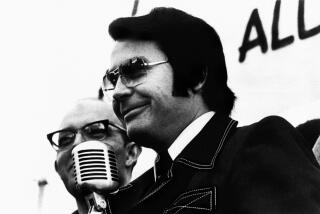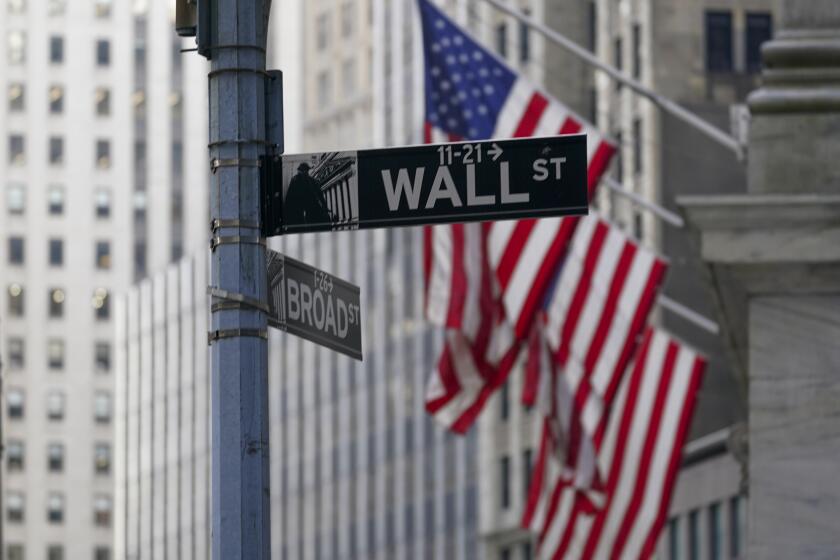How Steve Jobs and Apple turned technology into a religion
Decades after Apple’s founding, we’ve grown used to referring to lovers of the company’s products as a “cult.” The devotion of customers to Apple products has long been the envy of competitors for its fanatical fervor.
It turns out that the religious intensity with which people follow the company is not entirely by accident. In a new book, “Appletopia,” author Brett Robinson examines the way that Steve Jobs drew on religious metaphors and iconography to elevate his products specifically, and technology more generally, into a kind of religion.
PHOTOS: Biggest tech flops of 2013 -- so far
“The creative rhetoric around Apple’s technology has favored religious metaphors,” Robinson said in an interview. “Some of it is conscious on Apple’s part. Some of it is unconscious.”
Robinson is a visiting professor of marketing in the Mendoza College of Business at the University of Notre Dame. The book grew out his dissertation and a course he taught on religion, technology and marketing.
Jobs, of course, was a well-known devotee of Eastern spiritualism, including Zen Buddhism. He was a seeker of knowledge and transformative experiences who traveled widely and took LSD to expand his own consciousness.
From the very beginning of Apple, Robinson said, that spirituality was a part of the company’s philosophy and the way it marketed itself to people who had before only seen computers and soulless boxes used by big corporations to perform cold calculations.
Some of the iconography Apple borrowed is less than subtle. Its logo, for instance. The apple with a bite taken out of it suggests the Garden of Eden and the Tree of Knowledge.
But knowledge, in the Apple gospel, doesn’t bring about a downfall, but instead provides a moment of liberation, a path to enlightenment.
The enlightenment was an element, Robinson says, of Apple’s famous “1984” Super Bowl commercial, in which a female runner throws a hammer that smashes an Orwellian figurehead on a giant screen. Instead of a fiery explosion, the drones looking on are bathed in bright light as they seem to awaken and stir.
Of course, Jobs’ genius was that he always understood that computers and technology were about people. And it was what these gadgets could do and how they could transform our lives, not their features and specifications, that convinced people that the Mac could provide a transcendent experience.
Robinson references a conversation that Jobs reportedly had with marketing director Mike Murray before the launch of the first Macintosh.
“We don’t stand a chance of advertising with features and benefits and with RAMs and with charts and comparisons,” Jobs said. “The only chance we have of communicating is with a feeling.”
“It’s got to be a cult product,” Murray replied.
“Yeah, we say it’s a cult, and then we say, hey, drink the Kool-Aid,” Jobs said.
Apple even began to employ “evangelists” to spread the word about its products to developers and customers. And the return of Jobs later to Apple fed the religious allusions (i.e., Apple would be “resurrected” or “rise from the dead.”)
With the release of the iPod, Apple rolled out its series of silhouetted dancers who moved wildly, sometimes leaving psychedelic traces suggesting an LSD trip. Robinson said the ads implied that the anonymous dancers and iPod listeners could slip into an “ecstatic” and “divine” state with the right music.
“By donning the white earbuds and channeling the musical gods, the iPod listener takes part in a mobile, private and anonymous ritual practice,” Robinson writes.
The religious metaphors reached their peak, perhaps, with the release of the iPhone in 2007. By now, using religion to discuss Apple and Jobs were common, with one blogger even labeling the new gadget the “Jesus Phone” before its introduction.
Jobs played to that spiritual notion with a teaser ad with the slogan, “Touching is believing.” The reference, of course, is to the disciple Thomas’ statement that he would have to see the resurrected Jesus in person before he would believe that he had come back from the dead.
Robinson notes that the finger that’s reaching out in darkness to touch the phone also recalls Michelangelo’s painting in the Sistine Chapel in which God reaches out with a finger to touch man.
“The iPhone is not a cold and lifeless machine; it is an enchanted talisman, animated by touch,” Robinson writes.
Over time, Apple and Jobs were able to sell the notion that their products provided a kind of spiritual experience. People responded, Robinson says, by flocking to Apple stores, which became more like shrines, and were willing to wait in long lines to commune with fellow believers.
With Jobs’ death, the question now is how long Apple can retain that mystical hold on followers, Robinson said.
“There’s already a kind of dissipation of fervor around the brand,” he said. “That said, 10 years from now, we’ll still be talking about Steve Jobs. And that’s when the real mythmaking may begin.”
ALSO:
IPhone trade-in program may start Friday; you may want to skip it
Apple iPhone rumor roundup: Fast and gray 5S, cheap and plastic 5C
New iPhone 5S to go on sale Sept. 20? T-Mobile move suggests it will
More to Read
Inside the business of entertainment
The Wide Shot brings you news, analysis and insights on everything from streaming wars to production — and what it all means for the future.
You may occasionally receive promotional content from the Los Angeles Times.











